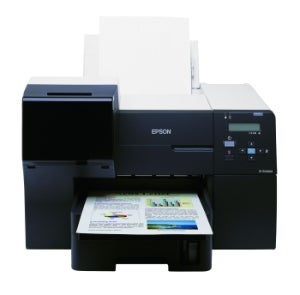As vital as printing is to just about any small business, it remains one of the more costly office expenses. Add a tight economy and shrinking budgets, and it’s no wonder most business owners are on the lookout for ways to print more economically. That’s the pain point Epson hopes to remedy with its latest printers designed for the small business and education markets.
Epson is positioning the B-300 and the B-500DN inkjet printers – which will both be available in September ‑ as reliable workhorses for the office or classroom. Anna Jen, director of business at Epson, said that both have been designed to deliver fast, high-volume, plain paper and color printing at a remarkably low page cost.
“The B-300 and the B-500DN represent Epson’s commitment to the business community by providing great productivity and an economical ink-cost per page,” she said. “They offer a superior balance between performance and price.”
 |
| Epson claims that the ink cost for its B-500DN inkjet, available in September, is as little as three cents per page for color. |
One feature that caught our eye: Both the B-500DN and the B-300 ship with standard-capacity cartridges (3,000 pages for black, 3,500 pages for color) – not those annoying “starter” cartridges that hold only half the ink of a standard cartridge. Epson also offers high-capacity and extra-high capacity (8,000 pages for black, 7,000 pages for color) cartridges.
The B-300
This printer will sell for approximately $329 and Jen said that it’s capable of printing up to 37 pages per minute (ppm) in draft mode. The printer includes a front-side, 500-sheet paper tray – enough to hold an entire ream of paper ‑ and a 150-page rear sheet feeder.
Other features include:
- Four individual, standard capacity ink cartridges
- Optional duplexer for double-sided printing
- Auto nozzle check system reduces nozzle clogging automatically
- USB 2.0 connectivity
- A monthly duty cycle of 10,000 pages (though Epson recommends 2,000)
Epson calculates the ink cost by dividing the cartridge MSRP by the cartridge yield, and claims the B-300’s ink cost comes in at less than 1.5 cents per page for black and five cents a page for color.
The B-300 accepts standard capacity cartridges only. Standard color cartridges (Cyan, Magenta and Yellow) yield 3,500 pages each and cost $49.99 per color. The black cartridge yields 3,000 pages and costs $39.99.
The B-500DN
Epson claims that the B-500DN, which will sell for $549, prints quality color at a cost-per-page similar to the costs of black-and-white pages from competitor printers. Like the B-300, it prints at up to 37ppm in draft mode, comes with the 500-sheet paper tray and 150-page rear sheet feeder.
Other features include:
- Ethernet network connectivity ‑ one printer can serve multiple offices
- USB 2.0 connectivity offices
- Highest yield ink cartridges provide about 8,000 pages (black) and 7,000 pages (color)
- Duplex (double-sided) printing
- Auto nozzle check system minimizes nozzle clogging automatically
- A monthly duty cycle of 20,000 pages (though Epson recommends 4,000)
In addition to Standard capacity cartridges, the B-500DN accepts both high capacity and extra-high capacity cartridges. High capacity color cartridges (Cyan, Magenta and Yellow) yield 7,000 pages each and cost $59.99 per color. The black high-cap cartridge sells for $49.99 and yields 4,000 pages.
The extra-high capacity cartridge comes in black ink only, yields 8,000 pages and costs $69.99.
Epson claims that ‑ when using the highest capacity ink cartridges ‑ the B-500DN’s ink cost comes in at less than one cent per page for black and three cents a page for color.
Lauren Simonds is the managing editor of SmallBusinessComputing.com
| Do you have a comment or question about this article or other small business topics in general? Speak out in the SmallBusinessComputing.com Forums. Join the discussion today! |

